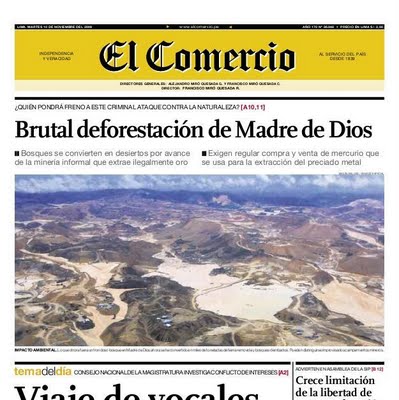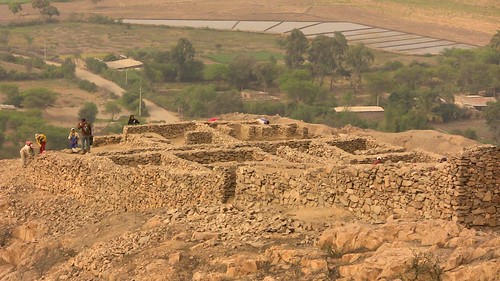Brutal deforestation in the Peruvian Amazon [Featured]
A little over a week ago, El Comercio published an article detailing the shocking environmental destruction in the Amazon by illegal independent mining operations, concluding with an interview that shows the government has no intention of stopping it.
Otto of the popular and highly recommended Inca Kola News translated the article, and the interview at the end with the “Mining Ministry Flunkey” who IKN states “knows what is happening, knows it’s illegal and knows that around 50 metric tonnes of mercury legally imported into Peru ends up being illegally sold in the disaster area but doesn’t want to do a thing to stop it. His arguments are laughable and clearly just wants to protect the status quo, not giving a damn about the enormous damage that current policies are causing. Viva investment grade.“
The original article is by Nelly Luna, the translation is provided by Inca Kola News.

El Comercio's front page
Forests are converted into deserts due to the advance of informal mining that illegally extracts gold. Regular buying and selling of mercury is demanded by locals, who use it for the extraction of the precious metal.
An overflight of the jungle between Madre de Dios and Puno offers a panoramic portrait of the devastation; thousands of tonnes of earth removed and forests disappeared or buried beneath the tailings left by years of intense and illegal exploitation of gold in the Amazon. It is possible to make out improvised mining camps, heavy machinery turning over the red soil, flows of rivers cut off and enormous pools of water that hold an un-noticed poison that keeps on accumulating: mercury.
This element is as necessary in the exploitation of gold as kerosene is in the production of cocaine. Because of this, mining engineers and environmentalists argue that if the sale of mercury is regulated, in the same way as chemical supplies are to combat narcotrafficking, a large part of the problem of illegal mining and the destruction of the forests. But this doesn’t happen; mercury is sold without any sort of control among the population that is found around the mining zones of Puno and Madre de Dios.
Supply and Demand
According to Customs information, in just the last four years the importation of mercury has nearly doubled, from 75,000kg imported in 2006 to 132,000kg last year. And so far this year, only up to September, there have been legal imports of 131,876kg of mercury. The Ministry of Energy and Mines (MEM) says that all these imports are basically used in artisanal mining, where levels of informality (no mining or land titles held or environmental impact studies approved) reach 90%.For every gram of gold produced, two or three times as much mercury is needed. A recent study by Cáritas estimated that more than 50 tonnes of mercury is used in the Madre de Dios region per year- Despite the large scale of the mining exploitation, tax evasion due to the informality of the industry is enormous; this region receives only S/15,000 (U$5,200) in mining royalties from the state.
Up to March 2009, the Institute of Geology, Mining and Metallurgy (Ingemmet) and the MEM had authorized 1,592 mining concessions in Madre de Dios and only 19 have approved environmental impact studies, with another 1,089 in process. There are also 87 mining concessions that overlap the Peru State Nature Reserve of Tambopata. According the the MEM, the control of current illegal mining is the responsibility of the regional governments.
“The mining concessions have been authorized without taking into account other existing rights such as agricultural properties, forestry concessions, conservation concessions and protected areas” according to the diagnosis of the Ministry of the Environment. With this disorder of concessions and a lack of controls, mercury is feeding into waters, lands and even in fishes. In improvised stores located around the mining zones such as Huepetuhe or Inambari, where the taxman never appears, one kilo of mercury sells for between S/150 and S/180 (U$52 to U$63) in jars with the ticket names American Mercury or El Español.
No Clear Rules
National rules establish that all companies that use mercury must have mechanisms that allow for the recapture and re-use of mercury, but nothing more. There is no rule that regulates the adequate final disposal or the metal. Experts say that the ideal situation would be to take it to safe depositories overseas (Peru does not have any). Without clear rules, each year more and more tonnages of this dangerous element arrives to stay (or evaporate) in some part of the country.It is worth mentioning that 83% of mercury imported by Peruvian companies comes from the United States or Spain. Mercantil SA, Triveño Mercury Corporation, JH Minerals, Aldo Orlando Torres Rojas and M&M Trading S.R.L. are the main importers. The quantities that arrive are mainly destined for the mining industry, with lesser percentages for the production of chlorine and dental curation work.
But mercury is not the only element used in illegal mining in the Puno and Madre de Dios regions. Every day, front load diggers arrive that cost half a million dollars apiece along with lorries, trucks, excavators and drags. The economic investment is very large, nothing to do with small mining. The Ministry of the Environment estimates that 50 truckloads of fuel arrives to the zone every day, 175,000 gallons of diesel and gas is used and approximately 1,500 litres of oil is spilled by the machinery and boats. Who will put a stop to this situation?
Interview with Víctor Vargas Vargas, Director General of Mining, MEM
“Prohibiting sales could generate contraband”“If the commercialization of mercury is regulated, wouldn’t it reduce illegal mining?
Mercury is freely traded. There are formal companies that import and sell it in a legal manner. If it were prohibited, it may generate contraband in this material.
Imports have nearly doubled in the last four years.
This is connected with the rise in price of gold, which causes a greater demand for mercury in the marketplace. What’s more, 98% of informal mining activity in the country is dedicated to gold mining and the basic ingredient is mercury. What we would like is that the technical requirements of the recovery of this element are complied with.
Therefore, mercury that arrives legally to the country finishes as being sold to illegal mining.Indeed. Anybody can buy mercury, just like they can buy gold. There are no restrictions. What is needed is to formalize these people and teach them to correctly handle this resource. Large mining companies do not use mercury, but cyanide. Mercury is only used in artisanal mining. However, there are mines that during the exploitation process obtain mercury as a by-product, for example in Yanacocha, that is then exported.
Is there a regulation, as there is for cyanide, that locates the final destination that the mercury must have?
There is no rule about its control, but there is perhaps thought of creating one, without aggravating the already existing problems. Blocking its commercialization would stimulate a black market and a rise in the price of this material.
Tags: amazon, environment, IKN, madre de dios, mining, pollution, rainforest, tambopata, [Featured]










